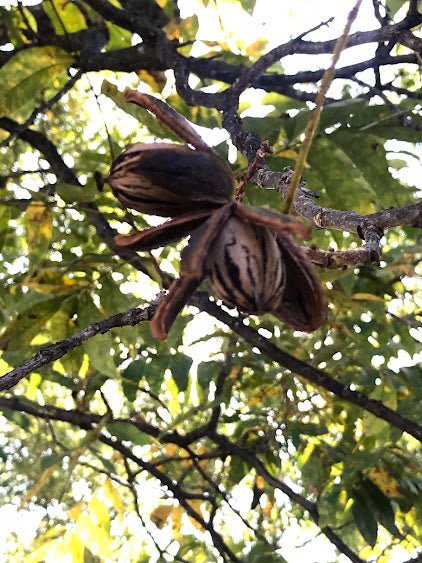
O. B. Harkey Pecan Grower, San Saba, Texas
A better title for this discussion would be “A choice of Pecan Varieties for the Harkey Grove.” After watching the growth and production of several varieties in the same orchard, a person can observe what he does and does not like in a variety.
Just what do we want in a pecan tree? We want an upright tree that is not characteristically willow in appearance, relatively free of crotches, that requires little pruning, and is attractive.
We want a variety that has sufficient number of average size leaves to synthesize carbohydrates (food) for the tree and also shade the branches. Extra-large leaves lose more water by transpiration than our low rainfall can supply. Excessively small leaves cannot provide enough food for a heavy set of nuts or provide sufficient protection from the sun. It is a matter of common knowledge that small leaves are ordinarily found on varieties that produce 60 to 70 nuts per pound.
A variety that produces a large number of flowers after danger of late spring frosts is desirable. However, it should mature uniformly and early.
A variety that produces nuts at various points along the twig is preferable to one that produces nuts in a cluster. This places the nut casebearer at a slight disadvantage for its movement over this longer distance from one nut to the other reduces its changes of avoiding contact with an insecticide.
A consistently bearing variety is preferable to one that overloads one year and misses the next. Some varieties will not bear two years in succession regardless of whether they overload on the productive year or not.
The desirable variety should be good enough to compete in the fancy pecan market. However, their shape should be such that they can be machine cracked and compete satisfactorily with native pecans. A nut that is easily cracked is one that has a thin shell and does not stick in the grooves of the shell.
The variety that we select as our best should also be easily propagated by budding or grafting.
At the present time Western Schley is the variety that comes nearer meeting the above requirements.
The Burkett variety is characterized by a choice nut but falls far behind the Western Schley in tonnage. It does very well in the lighter soils of the county.
The Onliwon is a pecan well adapted to the San Saba area but is not as profitable as the Western Schley. However, the Onliwon has some very desirable qualities.
The San Saba Improved is a fair producer and is well accepted on the market. However, the Onliwon and Western Schley are easier to harvest.
My discussion of pecan varieties is based upon 30 years of experience with 10 varieties in my grove. Although the other growers may have had different experiences, the Western Schley has produced two to three times as many pounds of pecans as any of the other varieties in my grove. It is important to plant more than one variety to obtain adequate pollination but it is a mistake to plant too many.

